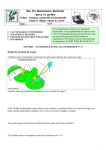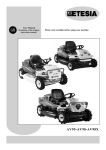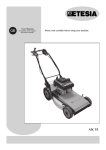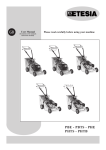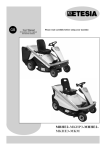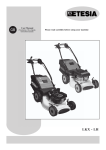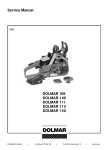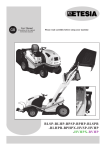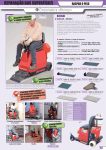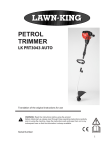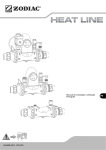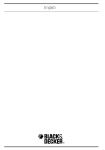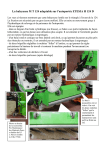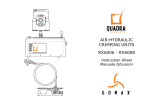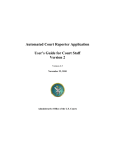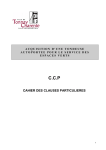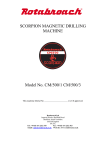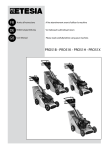Download Etesia SKF SKM ride on brushcutter mower owners operators
Transcript
GB
User Manual
(Translation of the originals
instructions manual)
Please read carefully before using your machine
SKM - SKF
Contents
1.
Your safety and that of others........................................................................................................................................................ 3
2.
Key to diagrams............................................................................................................................................................................. 5
3.
Illustrations.................................................................................................................................................................................... 9
4.
Pictures........................................................................................................................................................................................ 11
5.
Pictures accessories in option...................................................................................................................................................... 15
6.
Technical specifications............................................................................................................................................................... 16
7.
Operating instructions.................................................................................................................................................................. 17
8.
Assembly - Disassembly - Access to components....................................................................................................................... 20
9.
Maintenance................................................................................................................................................................................. 20
10.
Maintenance schedule.................................................................................................................................................................. 23
11.
Prolonged storage - winter storage.............................................................................................................................................. 23
12.Troubleshooting........................................................................................................................................................................... 24
13.
Accessories in option................................................................................................................................................................... 24
14.Warranty....................................................................................................................................................................................... 25
Y
ou are now the proud owner of an Etesia ride-on mower!
This extremely reliable and tough machine has been specially
designed to give many years of service.
• In order to prolong the life of your mower and keep it in excellent
working order, read this manual carefully and always follow the
safety recommendations and maintenance instructions.
• As part of our commitment to excellence, we are constantly
seeking new ways of improving our products.
• For this reason, your model may differ slightly from the description
in this manual.
• Up-to-date technical information can be obtained from your dealer
who will be happy to resolve any queries you may have.
Mower Identification
• The identification number of your mower is located on the left-hand
side of your mower (picture 1).
• Always quote this number when seeking advice from your dealer.
1• Your safety and that of others
• Always follow these instructions when using your ride-on mower.
• No responsibility will be accepted by the manufacturer in the event
of failure to comply with this manual or with current regulations.
• Prior to use, check that safety labels are present on the mower as
indicated in the manual.
Read these labels carefully.
If any safety labels are missing, inform your dealer immediately, as
the mower is required by law to carry them.
• Never remove warning labels or safety instructions.
• Before using your mower, make sure that you are completely
familiar with the controls and operating instructions so that you are
able to stop the machine quickly.
• Always keep the mower and accessories in good working order
• Never operate the mower using faulty guards or without the use of
safety devices.
• Do not attempt to adjust the engine speed controls.
• Never race the motor as this will increase the risks of injury to the
operator and the likelihood of damaging the components of your
lawn mower.
• Never allow your mower to be used by anyone who is not familiar
with the operating manual.
• Never use your mower on slopes with a gradient of more than 17°
(30%).
• Always observe the special instructions concerning use of the
mower on sloping ground.
• Never drive your mower too close to embankments or ditches, on
soft ground, or where there is a risk of overturning.
• The user is responsible for ensuring the safety of others within the
area where the mower is being used.
• Keep a safe distance from people and animals when the engine is
running.
• Never allow passengers to ride on the mower.
• Never allow children under the age of 16 to drive the mower.
• Always remove the ignition key when leaving the mower
unattended, even momentarily.
• Before using the mower, always check the condition and adjustment
of the blade.
• Never attempt to carry out work on or underneath the mower if it
has been raised on temporary supports or without taking proper
safety precautions.
• Before mowing, always clear the lawn of stones, pieces of wood or
metal, wire, bones, plastic, branches and other debris liable to be
thrown out by the mower.
• Low branches liable to cause injury to the user should also be
removed.
• Avoid obstacles such as mole hills, concrete pedestals, tree stumps
and edging, which cannot be cut by the blade and which could
damage the cutting mechanism specially the blade.
• Change absolutely the blade after any shock.
• Exercise particular care when reversing.
• Advance control: The advance control is a maintained-action safety
device: never lock it. Never put your foot astride the two pedals.
• The mower is not designed for towing.
• Never place hands or feet under the cutter housing.
• Whilst mowing, take care to avoid injury to others caused by flying
stones and other objects.
• Operate the mower only in broad daylight or with good artificial
lighting.
• Loose clothing and short trousers should not be worn when using
the mower.
• Always wear stout and closed shoes.
• When adjusting the engine or moving parts, always switch off the
engine and remove the ignition key. As a precaution, disconnect the
spark plug caps.
• Never operate the machine when feeling tired or unwell, or after
consuming alcohol or taking medicine.
• When the mower is driven on surfaces other than grass, disengage
the cutter and switch it to the fully raised position.
• Do not fill the tank whilst the engine is running. Allow the engine to
cool for few minutes before filling.
• Always use recently purchased petrol. Old petrol will leave gum
deposits in the carburattor, lead or leacks or make the engine difficult to start. Only buy as much unleaded petrol as is required
for less than one month. Store the petrol in a clean container which
is not used for other purpose.
• WARNING: fuel is highly flammable.
- Always fill the fuel tank in the open and do not smoke during this
operation.
- Add fuel before starting the engine.
- Never remove the fuel cap whilst the engine is running or hot.
- Avoid fuel overflow while filing the fuel tank. If in spite of these
precautions it should happen, check following :
a) Clean scrupulously all the contaminated parts.
b) Don’t start the machine as long as you’re not sure that all spilled
fuel has been eliminated.
• Ensure that the fuel tank and fuel can caps are replaced correctly.
• Never store, pour or use petrol near a naked flame or near devices
such as stoves, water-heaters with pilot lights or any other device
liable to produce sparks.
• WARNING : NEVER ALLOW THE ENGINE TO RUN IN
CONFINED AREAS.
Exhaust gases contain carbon monoxide, which is odourless and can kill.
• Do not start the engine if you can smell petrol, or in the presence of
other risks of explosion.
• DO NOT RUN THE MOTOR WITHOUT A SILENCER.
Examine the silencer regularly and replace as required.
• Clean the silencer and surrounding area regularly to prevent the
accumulation of grass and other flammable materials. Please cool
the engine a few minutes before you clean the exhaust.
• These precautions are vital to your safety.
However, the recommendations given are not exhaustive and due
care should always be exercised when using your mower.
• You should also comply with any legal requirements relating to
ride-on mowers (e.g. insurance, useful life, etc).
3
1• Your safety and that of others
• If the machine has to be lifted or transported, turn off the motor and
close the petrol tap.
• It is better to use a loading ramp to load or unload the machine.
Insuring your Riding Mower:
Under the terms of articles L 211-1 and the following, R 211-1 and
the following, and A 211-1 and the following of the Insurance Code,
it is mandatory to ensure all motor-driven land vehicles.
Your Riding Mower is not homologated for the use of the public
highway which is therefore prohibited to it.
You should not use this Mower until you have read the safety
instructions with care. Read this instructions manual carefully for the
use and maintenance of your mower.
SERVICING
. Always keep the machine and its accessories in perfect operating
condition.
. Replace worn or damaged parts for greater safety.
. Replace immediately the exhaust silencer if it is defective.
. Servicing and cleaning work on the mower must only be carried out
with the engine turned off. As a precaution, disconnect the spark
plug caps.
4
. It is highly unadvisable to use a high pressure cleaner at the risk of
damaging certain parts.
. Spare plates must only be fitted to mowers for which they are
designed, in conformity with the indications given.
. After an impact on a blade, it must be replaced.
RESPONSIBILITY
. In the event of failure to use the mower in conformity with the
instructions manual and the applicable regulations, ETESIA cannot
accept any responsibility.
. You must not make any modifications to your mower without the
prior agreement of ETESIA. Any modification not authorised by
ETESIA can make the machine dangerous and lead to severe injury
in use. In the event of failure to comply with these instructions
ETESIA cannot accept any responsibility.
2• Key to diagrams - SAFETY
• Labels
• Various labels have been affixed to your mower.
• Check that they are all present (see list below and pictures).
• Labels with a yellow background warn against risks.
• The other labels contain instructions for operating the mower.
This symbol appears in the instruction manual alongside
those sections which deal with user safety.
This symbol appears in the instruction manual alongside
important information on how to prolong the life of your
mower.
• Engine diagrams
Fuel is highly explosive and inflammable.
Stop the engine before fill the fuel tank. DO NOT SMOKE.
Always fill the fuel tank in the open and never pour or
use petrol near a naked flame or near devices such as
stoves, water-heaters with pilots lights or any other deviceiable to produce sparks.
Exhaust fumes are very toxic and contain carbone monoxide
who is a deadly and odourless poison. Do not run the engine
in confined areas.
To avoid any burn, do not touch the exhaust pipe
when it is hot.
Safety labels
Diagrams rectangle B (picture 2)
Diagrams rectangle A (picture 2)
• a = Risk of cutted feet and hands.
• a = CAUTION !
• c = Risk of objects projection and cutted feet.
• b = Before using, please read and follow the safety and maintenance
instructions of the instruction booklet.
• c = Stop the engine, disconnect the spark plug before proceeding
and remove key from ignition.
• d = Risk of projections.
• e = Avoid the presence of third persons in the danger zone.
• f = Fall down risk. Never transport passengers.
• b = Hold the third persons far from the machine.
• d = Never mow without the retracting parts of the cutting enclosure
in place.
Marking of accumulators
• a = Indicates that these hazardous products which should preferably
be returned to the distributor.
• b = (Pb) indicates the presence of lead.
• g = Hold the third persons far from the machine.
• h = Risk of toppling over the machine.
• i = Never use your ride on mower on slopes with a gradient of more
than 30% (17°).
5
2• Key to diagrams - SAFETY
1
Rectangle A
Rectangle B
2
6
2• Key to diagrams - SAFETY
Rectangle A
Rectangle B
Marking of accumulators
a
b
7
2• Key to diagrams - USE
• Engine speed
• Differential lock
• Indications for controlling engine speed:
START : position for starting the engine
MAXI : engine at full speed
MINI : engine idling
• Starting the engine
The arrow indicates the direction of pedal
movement to lock the differential
• By-pass
0 : engine off, power switched off
I : power switched on
1 : Lever in position I : bypass closed
= position advance transmission
engaged
0 : Lever in position 0: bypass open
= position advance transmission
disengaged
: engine started
• Parking brake
• Operating the cutter
• The arrow indicates the direction of movement
of the brake pedal in order to engage the parking
brake.
I : cutter switched on
0 : cutter switched off
• Cutting height
• Indicates the cutting height in mm (measured on
hard, flat ground).
8
• Lighting
• Horn
3• Illustrations
1
17
26
13
27
14
28
21
4
6
5
3
2
20
19
12
22
24
18
23
25
9
3• Illustrations
1. Engine hood catch
15. Advance control mode selection lever
2. Bypass control lever
16. Advance control pedals
3. Engine oil sump cap / gauge
17. Brake pedal
4. Hydraulic fluid expansion chamber cap
18. Differential lock pedal
5. Petrol tank cap
19. Parking brake locking lever
6. Petrol tap
20. Cutting height adjustment lever
7. Key switch - ignition key
0 = Off; 1 = Contact,
21. Steering column locking control
start
22. Seat longitudinal adjustment control
8. Cutting system selector
23. Seat tilting locking catch
9. Hour meter / Tachometer / Maintenance indicator
24. Seat suspension firmness adjusting knob
10. Horn
25. Tilted seat lock
11. Light switch
26. Trailer attachment
12. Fuses
27. Strap passage slot
13. Throttle control lever
28. Tow hook
14. Manual advance control lever
9
8
11
10
7
ORIGINAL SPARES ETESIA GUARANTEE
MC85M kit of 2 flails for SKM blade
MC85 kit of 2 flails for SKF blade (option on SKM)
18088 SKM, SKF engine oil filter
18116 spark plug (SKM, SKF)
25266 petrol filter (SKM, SKF)
25824 20A fuse
37762 set of 8 shear bolts
38383 can of 10W40 oil (engine and hydraulics - 2 litres)
10
4• pictures
1
a
a
2
3
4
11
4• pictures
2
1
3
5
6
8
17°
7
MC85M
MC85
9
10
12
4• pictures
Load applied to coupling point:
± 20 kg
Maximum load on trailer
axle: 270 kg
Maximum slope: 5°
11
12
14
13
13
4• pictures
15
16
b
a
17
18
19
20
22
21
14
4• pictures
a
a
24
23
MAXI
MINI
50 Nm
25
26
27
5• pictures accessories IN OPTION
MRM
MV80N
MAC
29
28
MET
30
MRL
31
32
15
6• TECHNICAL Specifications
990
2010
895
Model 970
SKM
SKF ENGINE
KAWASAKI FH 541 V 4 STROKE
Type Twin cylinder OHV
Bore x stroke
74mm x 68 mm
Cubic capacity
585 cm3
Power at 3600 U/min
17 CV (12,5 kW)
LubricationOil pump + Oil filter
Fuel type
95 super grade unleaded fuel
Cooling
Air-cooled
Starter motor 12 V electric
Alternator
12V - 13 A with rectifier
Spark plug
Standard Ø 14 x 9,5 mm - ref. 18116
Spark gap
0,75 mm
Ignitionelectronic
Petrol filter
paper filter
Air filter
Polyurethane foam filter + paper element
Rate
3200 ± 50 tr.min-1
Oil sump capacity
1,8 l (1,5 l without filter)
Petrol tank capacity
10 l
MOWER
Weight
285 kg (AV = 95 kg / AR = 190 kg)
Cutting width
85 cm, single blade
Blade housing
Masterschock + steel
Cutting height
5 positions : 44 - 60 - 75 - 88 - 102 mm
Blade clutch
electromagnetic
Safety systemsSwitches on drivers seat and parking brake
Frame design
Mechanically welded, multitubular structure
TransmissionHydrostatic with differential lock control and parking brake
Speeds
Forward gear : 0 to 10 km/h ± 1 Km/h - Reverse gear : 0 to 7 km/h ± 1 Km/h
Parking brake mounted on hydrostatic box
Dimensions L x l x H (mm)
2010 X 895 X 990
2010 X 970 X 990
Tyre sizes
Front : 13’’ x 5.00” - 6” - Rear : 18’’ x 5.00” - 8”
Tyre pressure
Front : 1,2 bar - Rear : 0,8 bar
Sound pressure at <85dB(A)
driver’s seat
SKM / SKF
Seat vibration level
(full body)
Steering wheel vibration level
(other appendages)
ahw = 1.22 m/s²
ahw = 2.49 m/s²
Directive EC/2006/42
reference standards:
EN836,EN1032,EN1033
Directive EC/2002/44
1.4 awx
0.42 m/s²
reference standards:
1.4 awy
0.69 m/s²
awz
1.07 m/s²
ISO2631-1,ISO5349-1+2
Daily exposure value
16
A (8)
1.07 m/s² during 8 hours
A (8)
2.49 m/s² during 8 hours
7• Operating instructions
7•1 Preparation and starting
up
7•5 Steering column tilt
adjustment
• Because of the technical nature of this operation, the preparation
and starting up of your mower are handled by your Dealer.
7•2 Safety systems
• Loosen the steering column locking control (picture 6).
• Adjust the tilt angle of the steering column and tighten the locking
control.
By pulling the control to the outside, you can relocate it freely.
Your mower has 2 safety switches, operated by the following items:
• The seat,
• The parking brake.
7•6 Turning the engine ON and
off
The engine can only be started under the following conditions:
• Parking brake applied and
• Cutting system selector not engaged.
The engine is turned off automatically if the driver leaves his seat
and:
• Either the cutting system remains engaged,
• Or the parking brake is not applied.
The cutting system can only be started if the operator is sitting on
the seat.
•In the event of a malfunction, stop the mower and contact your
Dealership.
7•3 Fuel
CAUTION DANGER!
Petrol is highly inflammable.
We recommend using 95 super grade unleaded and recently
purchased petrol. Buy only the amount of fuel you will be using
in 1 month and keep it in a clean tank designed specifically for the
purpose. Do not add oil to the petrol!
CAUTION!
Never use an additive. Do not use petrol/alcohol mixtures.
• Always fill the tank outdoors and do not smoke while filling
up. Avoid spilling petrol and overfilling the tank to prevent
overflowing: leave approximately 5 cm space under the filler collar
to allow the fuel to expand (picture 4, item B).
• Put the caps on the fuel tank and feed back in place.
• If you spill any petrol, when you smell petrol or when there is a risk
of other explosive conditions, do not try to start the engine but clean
carefully all the parts concerned and avoid causing any sparks until
the petrol vapours have dissipated.
7•4 Seat adjustment
7•4•1 Longitudinal seat adjustment
For safe driving, the position of the seat must be adjusted with
respect to the pedals.
• Pull the longitudinal seat adjusting control located underneath
the seat on the right outwards in order to be able to move the seat
backwards or forwards (picture 5).
The seat can also be folded forwards to keep it clean and dry.
7•4•2 Seat suspension firmness
adjustment
For optimum comfort, the firmness of the seat suspension can be
adjusted to your weight.
•Turned the adjusting knob to the right or to the left to increase or
decrease the firmness of the suspension (picture 5).
7•6•1 Turning ON
Before use, always carry out a visual check to
make sure that the cutting blade and its attaching
screw are not worn or damaged.
•Before starting the engine, always check the engine oil level. Top
up the oil if the level does not reach the mark:
[ FULL ], (see par. 9.3.1 and picture 3).
The oil gauge must be screwed down home when the engine
is running.
• Also check the level of the hydraulic fluid in the expansion cylinder.
The oil level must always be visible in the expansion cylinder (see
par. 7.4.2).
• Check the cleanliness of the air cooling inlet grille at the back of
the engine hood, the engine compartment and the hydrostatic axle
cooling fins. Also regularly check the condition of the fan.
• Top up with fuel in order not to have to add petrol during work
when the engine is hot.
• Open the petrol tap.
• Take place on your mower seat.
• Make sure that the cutting system selector is not engaged and that
the advance pedals are not operated.
• Turn the petrol control to the [ START ] position for cold starts
• Insert the ignition key and turn it to the right to the starting position
].
[
• When the engine has started, release the key and put the accelerator
control between the [ MINI ] and [ MAXI ] positions.
• Let the engine run for between 3 and 5 minutes before setting the
accelerator control to the [ MAXI ] position and starting the cutting
system.
To restart a hot engine, set the accelerated control directly to the [
MAXI ] position and start the engine.
The engine can only be started if the parking brake is applied and the
cutting system selector is not engaged.
CAUTION! Never leave the engine running in closed
areas where carbon monoxide, a dangerous substance, could
build up.
CAUTION! Never remove the petrol cap or add petrol
while the engine is running or when it is hot. Leave the
engine to cool for 2 minutes before topping up with petrol.
Do not change the original settings of the engine
and do not let the engine race. In the event of
maladjustment, contact your ETESIA dealership.
7•6•2 Turning off the engine
• Set the accelerator control to the [ MINI ] position then turn the
ignition key to the left, bringing it to the off position [ O ].
• Close the petrol tap for extended periods of stoppage.
17
7• Operating instructions
CAUTION! Never use the accelerator control [ START ]
7•8•3 Manual control lever for
advance
CAUTION! Never leave the ignition key in the ON
The advancing of your mower can also be controlled with the manual
control lever on your right. The advancing speed can be determined
more accurately in this way than using the pedals.
• Push the lever gradually forwards to regulate the forward speed.
• Push the lever gradually backwards to regulate the reverse speed.
• Release the lever to stop.
position to stop the engine.
position [ I ] when the engine is at a stop; the battery would
discharge slowly and the hour meter would continue to run.
CAUTION! When you leave the mower unattended,
remove the ignition key.
7•7 Turning the cutting system 7•8•4 Advance control mode
selection lever
ON and off
7•7•1 Turning ON
• Move the accelerator control to the [MAXI] position.
• Turn the selector on the dashboard to position [1].
• The cutting system will only start if the user is sitting on the seat.
7•7•2 Turning OFF the engine
• To turn off the cutting system, set the selector to position [0].
• If the operator leaves his seat, the engine cut-off device will stop the
cutting system.
Always turn the cutting system off before leaving your seat.
7•8 Driving the mower
The continuous advance control mode makes operation more
comfortable, in particular on a sloping surface, so that you can
maintain a constant speed of advance to suit the mowing conditions,
without having to keep your foot pressed on the advance pedal. You
can adopt a stable driving position by wedging your feet against the
running boards and driving your mowers safely using both hands.
This mode can only be used when travelling forwards.
•Bring the mower to the desired speed using the advance control
pedal.
• Push the control mode selection lever forwards to select the control
mode.
CAUTION! Never use the advance pedals while you
are using this control mode. However, you can correct the
speed using the manual advance control lever, without
leaving the control mode.
7•8•1 Parking brake
•To exit from the advance control mode, pull the control mode
selection lever back or, in an emergency, press the brake pedal.
The parking brake locking lever is on the left of the seat.
• To engage the parking brake, press the brake pedal all the way
down and then bring the locking lever to the rearmost locking
position. Lift your foot off the brake pedal before releasing the
parking brake lever which remains in the rearmost locking position.
• To release the parking brake, press briefly on the brake pedal. The
locking lever returns automatically to the forward position.
7•8•5 Differential lock control
Always engage the parking brake before leaving your seat.
Do not press on the brake pedal to slow down. Maintain
control of the advancing speed with dynamic braking
provided by the hydrostatic transmission and reducing the
action on the advanced pedal.
7•8•2 Advance control pedals
The advancing of your mower is controlled by the two pedals at the
front of the right running board.
• Before moving off, and release the parking brake.
• Operate the right-hand pedal gradually to adjust the forward speed.
• Operate the left-hand pedal gradually to adjust the reverse speed.
Never put your foot astride the two pedals.
The positions of the pedals determine the speed at which the mower
advances, stops (pedal up], maximum speed (pedal all the way
down), but also the dynamic braking.
• Release the pedal to reduce the advancing speed.
• Lift your foot entirely off the advance pedals to come to a stop: the
mower is slowed down gradually to a complete halt.
• To stop quickly, lift your foot off the advance pedals and press the
brake pedal.
18
From time to time, the differential can be locked, if one of the driving
wheels spins, to regain the drive needed for advancing.
•Press the differential lock control with the left foot to couple the
driving wheels. Keep the mower travelling more or less straight
ahead when the differential is locked.
•Release the pedal to return automatically to the normal
configuration as soon as the machine has recovered its driving
function.
CAUTION! Driving with the differential locked increases
the turn circle and makes the machine more difficult to
control and the risk of losing stability can be a danger to the
user.
7•9 Cutting height adjustment
lever
Press the button at the end of the cutting height adjusting lever
then pull the lever up or accompany it downwards, to lift or lower
the cutting plate. Release the button to lock the lever in the chosen
position.
• Use a setting of more than 75 mm when mowing tall and wet grass.
• Use lower settings for mowing flat and regularly maintained lawns.
7•10 MOWING
Before mowing, check the condition of the cutting
blade and its tightness.
To obtain a regular cut, it is important to check whether the tyre
pressures correspond to the recommended pressure; front tyres
1.2Kg/cm² - rear tyres: 0.8 kg/cm².
7• Operating instructions
When you are mowing with the cutting blade set low, it is essential to
move at a low speed in order to maintain a high engine speed.
Picture 8 illustrates the optimum way of using the mower on most
lawns. These indications will help you avoid tight turns and pointless
movements.
7•10•1 Tall grass mowing
For mowing exceptionally high grass, a cutting deck lateral ejection
device improves the efficiency of your mower.
Always turn the engine off and removed the ignition key
before changing the moving mode with the deflector open
or closed. Choose the mowing mode before starting to mow.
• Outside these servicing reminder periods, the display indicates the
engine running speed when it is operating.
• When at a stop, the total number of hours is displayed.
7•13 Tow hook
The tow hook is used for the occasional towing of low loads within
the following limits (picture 11) :
• Maximum load on trailer axle: 270 kg
• Load applied to coupling point: ± 20 kg
• Maximum slope: 5° (Including cambers)
SKM (Opening / Closing the deflector)
• Detach the toggle fastener closing the side deflector on the righthand side of the cutting deck. The deflector extends automatically to
the outside by a spring-loaded arrangement and the projection flap
takes position in front of the side ejection outlet (picture 9).
• Make sure that this protection flap is in place and in good condition.
Never use your mower in the side ejection configuration if the
protection flap is defective.
• To return to the mulching configuration, push the side deflector
towards the cutting deck, hook the toggle fastener in place and
secure it.
SKF (Opening / Closing the deflector)
• Loosen the knob at the rear right of the cutting deck and pull the
site deflector as far as possible towards the outside (picture 10).
• Tighten the knob to hold the deflector in this position.
• To return to the scything configuration, operate in reverse.
7•10•2 Driving on sloping ground
You can drive your mower on slopes of up to 17° (30%).
• To mow on sloping ground, always refer to the indicated mowing
diagram (picture 8).
• For safety’s sake, avoid abrupt starts and keep your speed low in
order not to lose control of the machine.
• When starting on a slope, going up or down, release the parking
brake and immediately put the machine into movement using the
advance pedals.
• Be particularly careful when manoeuvring, in particular when
making a U-turn.
• Get ready to change directions and reduce speed to avoid losing
control of the machine.
• As soon as the machine stops, apply the parking brake.
7•11 Lights and horn
• To turn the front light on or off, operate the light switch.
• To warn anybody about a danger, use the horn.
CAUTION! Even with this equipment, you are not permitted to
drive your mower on the public highway.
7•12 Hour meter / Tachometer /
Maintenance indicator
To simplify the maintenance of your mower, the hour meter/
tachometer will display a reminder message about the engine oil
change intervals (after 10 h then every 50 h).
• One hour before each change is due, a reminder will be displayed
and be maintained for the following two hours of operation, before
disappearing entirely.
19
8• Assembly - Disassembly - Access to components
8•1 Access to the engine,
petrol tanks and
hydraulic oil expansion
cylinders
8•3 Disassembling the cutting
deck
• Turn the engine off
• Remove the key from the ignition
• Pull the locking catch forwards and tilt the seat forwards (photo1,
item a). A compass locking arrangement holds it in the tilted
position.
• Insert your key ring in the slot of the engine hood closing catch and
turn it left to unlock, and then lift it to open. The engine hood locks
automatically when it is closed again.
• To fold down the seat, release the compass locking device with one
hand (picture 2, item a) and with the other hand, accompanied the
seat as it moves back to the driving position, and ascertain that it is
locked.
• Adjust the cutting deck to the highest position [ 102 ].
• Unhook the belt tensioning spring and clear the belt from the
cutting deck pulley.
• Adjust the cutting deck to the lowest position [ 44 ].
• Remove the 4 ring pins and the 4 pins (picture 24, item a).
• Move the cutting height adjustment leave it to the highest position
[ 102 ].
• From the side, remove the cutting deck from the machine.
8•2 Access to fuse box (see
description)
The box contains two fuses and is closed by a protection lid.
Whenever you need to work under the cutting housing, first
stop the engine and remove the key from the ignition. Wear
working gloves to protect your hands.
Reassembling the cutting deck
• Operate in the opposite order to disassembly.
8•4 Access to fuel tap (picture 23)
- Tap open: a
- Tap closed: b
9• Maintenance
Before carrying out any maintenance, stop the engine, and
remove the ignition key.
9•1 CLEANING
The best maintenance of all comes from regular cleaning of your
mower after each mowing job.
It is highly advisable to use a high pressure cleaner on it.
In any case, never spray water on to the engine parts such as:
carburettor, air filter, ignition circuit, exhaust, battery, etc Similarly,
never point the jet of water at electrical contactors, bearings (blade or
wheel bearings) or onto hydraulic parts.
After cleaning, it is advisable to restart the engine and the cutting
system to evacuate any water that might have got into the moving
parts.
9•2 CUTTING system
After each use, clean the cutting housing carefully, in particular on
the inside.
Before cleaning your mower, switch off the engine and ensure the
blade has stopped.
9•2•1 CLEANING THE CUTTING SYSTEM
BY DISASSEMBLY
If the mower has been used under particularly harsh conditions (very
wet grass, mowing in a very low position), it may be necessary to
disassemble the cutting deck to clean it.
At this time, it is also better to check the condition of the blade and
coupling, and replace them if necessary.
A properly maintained cutting system improves the cutting
quality. Clean the cutting system with a quick watering hose
connection (SKM).
20
On the left hand-side, the SKM model’s cutter housing is a fitting
allowing the collection of a quick union for watering (picture 12).
To clean the housing, proceed as follows:
• Connect the watering hose to the fitting provided on the cutting
housing.
• Open the tap
• Sit on the seat, start the engine and engage the cutting system.
• After approximately 3 minutes, the cutting system will be clean.
• After cleaning, close the water inlet and turn the cutting system
back on for a few moments.
9•2•2 MAINTAINING THE CUTTING
SYSTEM
Whenever you need to work on the cutting system, first
stop the engine and remove the key from the ignition. Wear
working gloves to protect your hands.
Shear bolts provide a connection between the body of the blade and
the blade coupling. In the event of violent impact, the instant shearing
of these screws protects the entire transmission system.
Every time before you use the mower, check the condition of the
blade (for any damage and wear).
If a blade has become blunt or is twisted, this will affect the standard
of cutting. A damaged blade could be particularly dangerous if a
piece comes away and is ejected by the cutting system.
Replace immediately any worn or damaged blades.
The flails on the SKF model are reversible: after the cutting edge
becomes worn, they can be turned around.
Also check that the blade coupling is in perfect condition and that the
blade ends turn in the same plane.
If any damage is observed on a blade, more thorough examination
of the other components will be necessary, for instance the cutting
housing, blade coupling, shear bolts, blade bearing and belt.
The blade can be tested through the opening of the side ejection flap
9• Maintenance
(SKM) or that of the side deflector (SKF) of the mower. If necessary,
remove the cutting system.
If you do not know how to do it or you do not have the right tools,
contact your ETESIA dealer.
9•2•3 REPLACING THE SHEAR BOLTS
• You can purchase a set of 8 shear screws and nuts P/N: 37762.
• Tighten the shear screws to a torque load of 10Nm.
• If you do not know how to do it or you do not have the right tools,
contact your ETESIA dealer.
9•2•4 REPLACEMENT OF BLADE BODY
• Lock the blade by placing a wooden wedge between it and the
cutting housing then detach the central screw with a 17 mm wrench
(picture 25).
• Before reassembling the blade coupling, Greece the shaft and and
check the condition of the lock washer (P/N 37665), on coupling
P/N: 37669), and key (P/N: 20602), (picture 7).
• Tighten the blade screw to 50Nm.
9•2•5 REPLACING THE FLAILS
• For the mulching housing (SKM), use spare part MC85M and
assemble according to the exploded view of picture 9.
• For the scything housing (SKF), use spare part MC85 and assemble
according to the exploded view of picture 10.
9•3 ENGINE MAINTENANCE
CAUTION! For all work on parts connected to the engine,
turn the engine off, remove the key from the ignition and
allow the engine to cool. Wear working gloves to protect
your hands.
9•3•1 OIL LEVEL CHECK (See picture 3)
To be checked before each mowing job
Bring the mower on to a horizontal area
• Open the engine cover (C §8.1)
• Clean the perimeter of the filler hole to prevent impurities from
getting into the housing.
• Unscrew the dipstick.
• Wipe the dipstick with a clean cloth and put it back into the filler
tube
• Put back the cap so that it bears on the tube but do not screw it
down.
• Pull out the dipstick to check the level:
the level of the oil on the dipstick should be between the [AND]
and [is FULL] or {Min} marks (see picture 3). See the technical
specifications for the capacity of the sump.
• Screw the dipstick back in securely.
9•3•2 ENGINE OIL CHANGE AND LEVEL
• Close the drain tap.
• Clean the surroundings of the gates to prevent any impurities from
getting into the engine housing.
Remove the oil gauge and slowly pour in 10W40 multigrade oil,
specification API-SL or ACEA-A3 P/N ETESIA 38383 (2 litres) or
an SAE30 monograde oil through the filler pipe.
• Wipe the dipstick with a clean cloth and put it back into the filler tube.
• Put back the cap so that it bears on the tube but do not screw it down.
• Check the oil level using the gauge. The level must reach the
[FULL] mark without going beyond it.
• Screw the dipstick back in securely.
• Leave the waste oil with an approved recovery station.
9•3•3 OIL FILTER
Replace the oil filter every 100 hours of operation.
A hot engine can cause serious burns. Allow the engine to
cool before trying to disassemble the oil filter.
• Place a suitable recipient under the filter to collect any oil outflow
on this assembly.
• Unscrew the oil filter and remove it (picture 14).
• Apply a film of clean engine oil to the seal of the new oil filter.
• Screw the filter by hand until the seal comes into contact with the
bearing surface.
• Then tighten by 3/4 turn.
• Turn the engine on and leave it run for approximately 3 minutes.
• Turn the engine off, check that the filter seal is tight and top up the
engine oil to compensate for the lowering of the oil level due to the
capacity of the oil filter.
9•3•4 AIR FILTER
Clean the air filter (picture 15) every 50 hours and more frequently if
the conditions are particularly dusty.
Replace the paper filter element every 100 hours or at the least once
each year.
• Spread the catches apart with your fingers, unhook them and
remove the box and the foam filter [ A ].
• Unscrew the wing nut and remove the paper filter element [ B ].
• Clean the inside of the box.
• Wash the foam element in water and detergent and dry it
thoroughly.
• Clean the paper element by tapping on it lightly to knock out the
dust. If it is very dirty, replace it by a new one.
• Install the paper element and tighten the wing nut.
• Arrange the foam element in its special location in the paper element.
• Install the box, hook up and close the catches.
Do not wash the paper element. Do not apply oil to the filter
elements. Do not clean the paper element with compressed
air as it would damage it.
After the initial servicing at 10 hours, to be performed by your
ETESIA dealer, the engine oil must be changed at the first of the
following occasions: every 50 hours or once each year.
In dusty places, shorten the cleaning or replacement
intervals.
Change the oil when the engine is still hot to obtain better outflow of
oil than when cold.
Never start the engine without the air filter being in place.
• Take the machine outdoors to a horizontal surface.
• Turn the engine off and remove the ignition key.
• Place a suitable recipient at the oil drain outlet at the back of your
mower (picture 13).
• Using a large screwdriver inserted in the hole provided in the lefthand mudguard, open the drain valve and allow the spent oil to flow
into the recovery recipient.
9•3•5 PETROL FILTER
• If you engine lacks power or runs irregularly it may be due to the
fouling of the petrol filter (picture 16). It must then be replaced.
• However, it is advisable to replace this filter every 100 hours or at
least once every year, even if it still appears to be in serviceable
condition.
Be careful of the hot oil drained off.
21
9• Maintenance
9•3•6 SPARK PLUGS
Do not remove the spark plugs until the engine is totally
cold.
Clean the spark plugs and adjust the electrode gaps or replace them
after every 100 hours of operation.
• Disconnect the spark plug caps and unscrew the spark plugs.
• Clean the electrodes [picture 17 item a ] with a wire brush to
remove any scale.
• Check the porcelain for cracks and make sure that the electrodes
are not excessively worn. If necessary, replace the spark plugs (P/N
18116).
Using a feeler gauge, check the electrode gaps [ b ] which should be
0.75 mm. If necessary, correct using the side of electrode only.
• Install the plugs and tighten them to 22 Nm.
• Then connect the spark plug caps.
9•3•7 COOLING SYSTEM
Before each use check that the air inlet grille at the back of the engine
hood is not blocked with grass or other debris and clean as necessary.
Once every year or every 100 hours of operation
• Remove the air inlet conduit insert inside the engine hood and clean
the inside of the conduit (picture 18).
• Remove the engine cooling volute and clean the cylinder cooling
fins and the inside of the cooling volute.
Never turn the engine on before reinstalling all the
parts of the cooling system.
9•4 ADVANCE TRANSMISSION
MAINTENANCE
9•4•1 HYDROSTATIC AXLE
Regularly clean the cooling fins of the hydrostatic axle and check that
the fan is also in serviceable condition.
Have your ETESIA dealer change the oil and replace the oil
filter after 50 hours of operation, then every 250 hours.
9•4•2 HYDRAULIC FLUID LEVEL
The hydraulic fluid expansion cylinder is combined with the petrol
tank (picture 4).
Before unscrewing the hydraulic fluid cylinder cap, clean it carefully
and check that no impurities are able to enter into the cylinder.
Check the level of the hydraulic fluid before each use. Do
not fill the expansion cylinder but make sure that the oil
level is always visible in it, (picture 4, item A), in particular
when the cold (normal level approximately 1 cm above the
bottom of the cylinder).We recommend a can of 10W40
grade oil P/N 38383 (2 liters).
9•5 BATTERY MAINTENANCE
9•5•1 MAINTENANCE
Your mower has a lead storage battery in the engine compartment
requiring a minimum amount of servicing. Check the electrolyte level
every 50 hours. The level should be between the lower level (item [
MINI ]) and the higher level (item [ MAXI ]) in each of the cells.
If the electrolyte level of the battery (picture 27) when charged
is close to the [MINI] mark, add distilled water to bring it up to
[MAXI].
22
The battery contains sulphuric acid which is particularly
dangerous and can cause serious burns in contact with
the skin or the eyes. Take great care when using it. Wear
protective clothing (gloves, goggles, etc) when topping
up the electrolyte level. In the event of contact with the
skin or the eyes, rinse in copious amounts of water. Where
applicable, contact a doctor immediately.
The battery and the acid must be kept out of reach
of children. Never allow the battery to overflow. If it
overflows, rinse the party concerned immediately in copious
amounts of clear water to prevent their corrosion.
Regularly check whether the battery terminals are oxidised. Where
applicable, clean and grease them.
If the battery has to be removed, always disconnect the negative
terminal first, followed by the positive terminal.
9•5•2 BATTERY CHARGING
CAUTION! Never disconnect the battery when the engine is
running.
Use a suitable 12V charger. The charge current must not
exceed 2A.
Connect to the charger to the right poles of the battery.
The charge time can be up to 12 hours depending on the initial charge
condition.
The battery gives off an explosive gas mixture during
charging. Avoid any claims or sparks and do not smoke
nearby. Do not carry out charging unless the room is
properly ventilated.
At the end of charging, check the level of the electrolyte. If
necessary, top up to the higher level using distilled water.
CAUTION! A battery left in the discharge condition will
not recharge subsequently.
9•5•3 ELIMINATING YOUR BATTERIES
Batteries contain dangerous material and should never be dumped
into the natural environment. They come under precise rules of
elimination (directive 2006/66/CE). You can entrust your used
ETESIA batteries to your ETESIA dealer who will deal with their
elimination, or to selective refuse sorting facilities designed for the
purpose.
9•6 TYRE MAINTENANCE
Always maintain the right tyre pressures:
- 1.2 kg/cm2 in the front wheels,
- 0.8 kg/cm2 in the rear wheels,
Other pressures than those recommended could have a negative effect
on turning or on the traction of the mower.
They could even cause loss of control of the mower .
10• Maintenance schedule
After the first 10 hours
After the first 10 hours, we advise you return the
machine to your ETESIA dealer for inspection
Page
Component
Always before
moving
Every
50 hours
Every
100 hours
EveryObservations
250 hours
Or annually (at the 1st of the occasions)
21
Engine Oil
Check level and
ReplaceOil 10W40 top up Can ref: 38383
21Motor Oil Filter Replace
Ref : 18088
21
Air filter
Clean
Replace
21
Petrol filter
ReplaceRef. : 25266
22Spark plug
Clean, adjustRef. : 18116 or replace
Cooling system
Remove grass from
Clean under the
grilles
engine volute
22Hydraulic oil
Check level and
Make replace
Make replaceOil 10W40
top up
after 50 hours
Can 2L ref: 38383
22Hydrostatic oil Make replace
Make replace
filter
after 50 hours
21
Blade coupling
Check condition
of tightness
20
Blade
Check conditionReplace if and tightnessdamaged
22
Battery
Check level and
Maintain loaded
top up distilled water
Tyres
Check tyre FRONT : 1,2 kg / cm²
pressure
BACK : 0,8 kg / cm²
11• Prolonged storage winter storage
11•1 PREPARATION FOR WINTER
STORAGE
• Clean the machine thoroughly, in particular the cutting deck.
• Grease moving parts and change the engine oil.
• Empty as much fuel as possible from the fuel tank and run the
engine until all the fuel has run out.
• Disconnect the spark plug caps and unscrew the spark plugs.
• Injects a small amount of oil (1 cl/10 cm3) into the spark plug hole
of each cylinder.
• Run the starter very briefly using the ignition key, to spread oil
through the cylinders.
• Screw the spark plugs by hand without putting the caps back on
• Remove the battery, disconnecting the negative pole first.
• Completely recharge the battery.
• Store the battery in a dry and cool place, protected from freezing.
• Complete the charging of the battery every two months.
11•2 RETURN TO SERVICE
• Unscrew the spark plugs and clean them with petrol. Allow to dry
but do not put them back for the time being.
• Reinstall and reconnect the battery.
• Operate the starter very briefly using the ignition key to eliminate
any excess oil from the cylinders.
• Then fit the dry spark plugs and connect the caps.
• Check the oil level and top up with fuel.
• You are now ready to restart the engine.
CAUTION! Do not store, pour or use petrol near a naked
flame or near equipment such as ovens, water heaters using
a pilot light or any other device liable to generate a spark.
23
12• Troubleshooting
12•1 FUSE REPLACEMENT
12•5 CHANGING WHEELS
The fuse holder is on the left hand side of the steering column under
the dashboard.
- Upper fuse: 20 A / protection of battery charge circuit
- Lower fuse: 20 A / protection of the main power supply circuit
Is a wheel has to be removed from the mower, do it on firm and flat
ground.
Do not carry out any work on or under the mower if it has been raised
provisionally or if safety conditions are insufficient.
If you do not have the right tools or knowledge, please contact your
ETESIA dealer. Proceed as follows to remove the wheels:
12•2 MOVING THE MOWER WITH
THE ENGINE OFF - By-pass of
hydrostatic axle
To be able to move the mower without using the engine, it is necessary
to set the hydrostatic axle bypass control to [ O ] (picture 22).
The bypass control lever is accessible under the chassis at the back of
your mower.
Caution! Risks of burns! Do not touch the exhaust
silencer if it is still hot.
Position [ I ] : bypass closed = advance transmission position
engaged
Position [ O ] : by pass open = advance transmission position
disengaged to move the mower over short distances without the
engine.
• After movement, remember to put the hydrostatic axle bypass back
in the operating position [ I ].
12•3 TOWING THE MOWER
Set the hydrostatic axle bypass to the position [ O ].
• Use only a tow bar for an attachment to the telework at the front of
the mower (picture 21). Do not use any other towing points.
• After movement, remember to put the hydrostatic axle bypass back
in the operating position [ I ].
Caution! Towing must only be carried out over short
distances and at low speed (less than 5 km/h).
For towing over longer distances, use a suitable means of
transport (trader or utility vehicle).
12•4 TRANSPORT
Front wheels
Stop the engine and remove the ignition key.
• Apply the parking brake and immobilise the machine using chocks
under the rear wheels.
• Place a jack at the front, beneath the chassis, and lift the mower
(picture 19-1).
• Secured the machine by standing it on stable screw jacks (picture
19-2).
• Remove the protection covers then pull out the locking clips.The
wheels can now be removed from their shaft.
• Operate in the opposite order for assembly, making sure that you
clean and grease the wheel shafts.
• Check the tyre pressures: 1.2 kg/cm2.
Rear wheels
• Stop the engine and remove the ignition key.
• Apply the parking brake and immobilise the machine using chocks
under the front wheel and the other rear wheel.
• Loosen the 4 attaching studs of the wheel to be removed.
• Place a jack under the chassis on the same side as the wheel to be
removed and lift the wheel off the ground (picture 20-1).
• Secure the machine by standing it on stable screw jacks (picture
20-2).
• Undo the studs and remove the wheel.
• Proceed in the opposite order for reassembly.
• Tighten the screws to 50 Nm.
• Proceed in the same way for the other wheel.
• Check the tyre pressures: 0.8 kg/cm2.
Eliminating worn tyres
It is forbidden to abandon or deposit tyres in the natural environment
or burn them in the open air. Our sales network is informed that the
obligation to take back ETESIA riding mower tyres free of charge.
It is better to use a loading ramp to load or unload the mower on a
trailer or a utility vehicle.
After loading:
• apply the parking brake and place chocks under the wheels
• close the petrol tap.
• tie down your mower with straps run through the tow hook (see
description, item 28) and the slot (item 27) of the tow hook.
13• Accessories IN OPTION
Seat armrests P/N MAC
(standard on SKF) (PICTURES 28)
Armrests greatly improve driving comfort, in particular when your
mower is being used on a slope. They are easy to attach to the seat
back rests by 4 screws.
General-purpose garden trailer
P/N MRM (PICTURES 29)
This trailer is light and robust, very practical for transporting
gardening equipment. The hollow structure of the skip forms an 85
litre tank for carrying water or phytosanitary products. As an option,
it can be equipped with a spray monitor (P/N MRL, picture 31).
24
Snow clearing blade P/N MV80N (PICTURES 30)
Designed for clearing snow from aisles and outside areas. Adjustable
to the right or to the left.
Spreader P/N MET (PICTURES 32)
Having a hopper capacity of 60 L, this wheel-driven distributing disc
spreader is ideal for spreading snow clearing salt and sand.
14• Warranty
DEfinitions
• Dealer, importer = Distributor linked to ETESIA by an agreement
(dealership or importer contract). The dealer and the importer are in
charge of selling and servicing ETESIA machines.
• User, buyer = physical or moral person, company, collectivity or
association having bought legally a machine new or second hand
from a dealer.
• Domestic use = use of a machine on a private ground. Machine is
owned by the user and just use to clear its private piece of ground
(main or secondary residence).
• Professional use = use of an ETESIA machine, in exchange of
money or not, on public areas to maintain companies or institutions
like : hospitals, associations,….or on private fields being owned by
a third person.
• The user completes the warranty card indicating the type of use
for every machine. This declaration engages its responsibility and
defines the legal warranty period.
• Should ETESIA discover that the machine is not used in the use
initially declared, ETESIA allows itself to cancel the warranty.
• Wear parts/consumable parts : parts needing to be changed
inevitably to enable an optimal normal use of the machine.
• Normal use = use of the machine according to all instructions
mentioned in the instruction book (including safety and
maintenance).
General warranty conditions
• In addition to the legal warranty, ETESIA offers a contractual
warranty. The ETESIA warranty concerns the exchange of parts
free of charge in case of material, production or conception
fault. This warranty applies on the product as he leave ETESIA
production line.
• The delivery company is the only responsible in case of transport
damage. It is however the addresse responsibility when damages
occurs during transport to mention reserves on the delivery note
when receiving the goods and to inform ETESIA within 48H by
registered letter.
• The instruction book delivered with every machine contents all
information regarding machines use. Any different use from the
one described in the instruction book can be dangerous for the user
and reduce machine life. In such cases, ETESIA can not be held
responsible.
Contractual warranty
• The ETESIA contractual warranty is allowed for one year in
professional use and for 3 years on domestic use (warranty period
starting the first day when the machine is purchased by the user).
This warranty is just valid if :
1) Instructions from the instructions book have been respected.
2) The warranty card has been returned to ETESIA immediately after
the machine purchase or completed on the extranet site.
3) A revision is recommended after periods indicated in the
instruction book.
4) To require a repair under warranty claim, the buyer will contact
first the ETESIA dealer. Should it not be possible, he could contact
ETESIA who would propose an alternative solution.
5) Just repairs done in ETESIA dealers workshops can be taken under
warranty.
6) Any material, production or conception fault recognized by
ETESIA as such will be eligible to warranty (parts and labour). It
will therefore be paid back to the dealer according to charge scale
mentioned in the agreement. It is dealer responsibility to make
sure that the end user does receive the complete warranty allowed
by ETESIA. Should ETESIA not recognize any fault, the dealer
will be held responsible. ETESIA reserves the right to cancel the
decision with no compensation or warning.
Transportation cost for machines and parts are at user cost.
7) Any intervention done within warranty time, in particular in case
of parts exchange, will not give right to any new warranty period.
8) In case of parts exchange under warranty, ETESIA reserves the
right to use either new or second hand parts. Parts given free of
charge by ETESIA can required at any time by ETESIA.
They need to be sent back on simple request. Should ETESIA
not receive these parts, warranty claim would automatically be
cancelled.
9) This warranty however does not cover : parts damaged during a
repair action ; machines not having been serviced according to
the repair schedule mentioned in the instruction book ; parts with
normal wear.
Please find a list (not complete) of wearing parts: spark plugs,
filters, exhaust, seals, membranes, blades, blade coupling parts,
belts, clutchs, batteries, battery electrolytes, control cables, sheath,
fuel pipes, durits, cooling liquid, hydraulic and lubrication liquids,
fuel, seat, bonnets, grassbox, material grassbox frame, mudguards,
pedal covers, running board cover, anti scalp kit, roll axle...
10) Warranty right is cancelled in the following cases:
- Damages due to non respect of safety, maintenance use and
storage instructions. ETESIA will not be held responsible,
legally in particular, for damages resulting from other uses than
the ones described in the instruction book.
- Damages due to accident or collision.
- Damages due to a modification of the original machine or use of
non original spare parts.
- Damages on machines not having been maintained by the
ETESIA dealer network.
11) In case of owner change, the outstanding warranty period can be
transferred to the new owner. However to enable this transfer a
written request need to be sent to ETESIA after sales department.
This request needs to attest as well that the new end user has
received the instruction book for the machine as well as the
warranty terms.
12) ETESIA keeps the right to check that preliminary conditions for
warranty have been respected by the buyer.
13) When warranty application is requested, ETESIA does deliver the
parts as soon as possible. However an immediate delivery can not
be requested. A delay in delivery would in no case give right to
compensation or to warranty extension.
14) Any additional claims to ETESIA is excluded.
15) Any breakdown suspected as being a fault subject to warranty
has to be brought to attention to an ETESIA dealer. The ETESIA
dealer is in fact the only contact able to submit a warranty claim
to ETESIA.
Should a dispute occur the competent tribunal is the one
mentioned in the ETESIA dealership.
Important note :
As soon as a machine purchase takes place, the warranty cards needs
to be :
- completed, signed and sent back to
ETESIA – warranty Service
67165 WISSEMBOURG CEDEX
France
- or completed on line on the extranet
25
CE declaration of conformity
As per Directive EC/2006/42
We,
13, Rue de l’Industrie, 67165 WISSEMBOURG CEDEX
declare under our responsibility, that the ride-on lawnmowers, type A85, reference SKM, SKF to which this declaration refers, fulfil all the
relevant terms of directive 2006/42/EC applicable to them as well as to the provisions of all other directives European applicable to them :
- EC 2004/108
- EC 2006/66 - EC 2000/14
Electromagnetic compatibility
Concerning batteries and accumulators containing certain dangerous substances
Noise emission in the environment by equipment for use outdoor
and guarantee that the ride-on lawnmowers, type A85, reference SKM, SKF meet the requirements of Directive EC/2000/14 regarding noise
emissions in the environment, and are subject to the internal production control procedure, with evaluation of the technical documents and
periodic inspection by a notified body, the CETIM, F-60304 SENLIS CEDEX.
- Average acoustic power level measured : 97 dB(A)
- Guaranteed acoustic power level : 100 dB(A)
Mr Freddy Schmitt
13, rue de l'industrie 67165 Wissembourg CEDEX
is the person authorized to constitute the technical file :
Assessment of conformity ti in-house inspection of machine manufacture according to Annex VIII of directive 2006/42/EC.
Modell :
Année de fabrication
Serial number:
Mr. Patrick VIVES
Due to their permanent improvement policy, ETESIA reserves the
right to modify specifications, text and pictures without prior notice.
ETESIA SAS - F - 67165 WISSEMBOURG CEDEX - Strasbourg Trade & Commerce Register B343 510 996
The President
13305_08_052013i1
Done in Wissembourg, the 16/05/2013
Stamp
here
please
ETESIA
SERVICE GARANTIE
13 rue de l'Industrie
67165 WISSEMBOURG CEDEX
France
This card has to be returned completed to ETESIA upon the first setting up.
SERIAL
NUMBER:
WARRANTY CERTIFICATE
USERNAME____________________________ Forename__________________________
Street____________________________ Zip code___________________________
Town __________________________ Country____________________________
Tel _______________________________ Date of purchas _____ _____ 20____ Day
Month
Year
@ Email : ________________________________________________________________________
Automatic lawnmower ETMower - Track and Trace : User code query
Contact : __________________________Cell phone number for SMS information : ______________
- Dealer : _________________________________- Installer : _______________________________
- End user ________________________________ - Importer : _______________________________
Installation provided by : _____________________________________________________________
I already own an ETESIA q yes - q no
Dealer's stamp and signature
Tel. number
Date :______________________________________________
MODELL:
Area to be mown:
Mowing frequency:
I am, I represent:
q Less than 1000 m2
q 1000 to 2000 m2
q 2000 to 5000 m2
q 5000 to 10 000 m2
q 10 000 to 20 000 m2
q More than 20 000 m2
q More than once the week
q Once the week
q Twice the month
q Once the month
q Less than once the month
q A privat
q An association, a company
q A council, a collectivity
q A landscaper (green areas professionnal)
q Other, specify ________________________________________
Signature
and confirmation of the user :
- that he has taken possession of a machine in perfect working order ;
- that the user has been handed over and that he thoroughly read the use instructions, safety and maintenance suggestions figuring in it ;
- that he has been informed of the warranty terms and that he accepts said terms without reserve or restriction ;
- that he has been informed by the ‘’Contract of breakdown service per alarm « GPS »’’ (automatic lawnmower ETMowers)
Date_________________________
Signature____________________




























